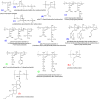Temperature-Responsive Polymer Brush Coatings for Advanced Biomedical Applications
- PMID: 36236192
- PMCID: PMC9571834
- DOI: 10.3390/polym14194245
Temperature-Responsive Polymer Brush Coatings for Advanced Biomedical Applications
Abstract
Modern biomedical technologies predict the application of materials and devices that not only can comply effectively with specific requirements, but also enable remote control of their functions. One of the most prospective materials for these advanced biomedical applications are materials based on temperature-responsive polymer brush coatings (TRPBCs). In this review, methods for the fabrication and characterization of TRPBCs are summarized, and possibilities for their application, as well as the advantages and disadvantages of the TRPBCs, are presented in detail. Special attention is paid to the mechanisms of thermo-responsibility of the TRPBCs. Applications of TRPBCs for temperature-switchable bacteria killing, temperature-controlled protein adsorption, cell culture, and temperature-controlled adhesion/detachment of cells and tissues are considered. The specific criteria required for the desired biomedical applications of TRPBCs are presented and discussed.
Keywords: biomedical applications; brushes; coatings; temperature-responsive polymers.
Conflict of interest statement
The authors declare no conflict of interest.
Figures













Similar articles
-
Non-proteinaceous bacterial adhesins challenge the antifouling properties of polymer brush coatings.Acta Biomater. 2015 Sep;24:64-73. doi: 10.1016/j.actbio.2015.05.037. Epub 2015 Jun 17. Acta Biomater. 2015. PMID: 26093067
-
Thermo-responsive polymer brushes on glass plate prepared from a new class of amino acid-derived vinyl monomers and their applications in cell-sheet engineering.Colloids Surf B Biointerfaces. 2017 Nov 1;159:39-46. doi: 10.1016/j.colsurfb.2017.07.068. Epub 2017 Jul 27. Colloids Surf B Biointerfaces. 2017. PMID: 28779639
-
Toward Infection-Resistant Surfaces: Achieving High Antimicrobial Peptide Potency by Modulating the Functionality of Polymer Brush and Peptide.ACS Appl Mater Interfaces. 2015 Dec 30;7(51):28591-605. doi: 10.1021/acsami.5b10074. Epub 2015 Dec 21. ACS Appl Mater Interfaces. 2015. PMID: 26641308
-
Infection Resistant Surface Coatings by Polymer Brushes: Strategies to Construct and Applications.ACS Appl Bio Mater. 2022 Apr 18;5(4):1364-1390. doi: 10.1021/acsabm.1c01006. Epub 2022 Apr 4. ACS Appl Bio Mater. 2022. PMID: 35377592 Review.
-
Biopolymer Coatings for Biomedical Applications.Polymers (Basel). 2020 Dec 21;12(12):3061. doi: 10.3390/polym12123061. Polymers (Basel). 2020. PMID: 33371349 Free PMC article. Review.
Cited by
-
Determination of the significance of atomic concentration on surface properties of Ba x Mg1-x F2 alloy coatings via microscopic and spectroscopic techniques.RSC Adv. 2024 Aug 19;14(36):26043-26049. doi: 10.1039/d4ra05211k. eCollection 2024 Aug 16. RSC Adv. 2024. PMID: 39161445 Free PMC article.
-
QbD Design, Formulation, Optimization and Evaluation of Trans-Tympanic Reverse Gelatination Gel of Norfloxacin: Investigating Gene-Gene Interactions to Enhance Therapeutic Efficacy.Gels. 2023 Aug 15;9(8):657. doi: 10.3390/gels9080657. Gels. 2023. PMID: 37623112 Free PMC article.
-
Strategies for Developing Shape-Shifting Behaviours and Potential Applications of Poly (N-vinyl Caprolactam) Hydrogels.Polymers (Basel). 2023 Mar 18;15(6):1511. doi: 10.3390/polym15061511. Polymers (Basel). 2023. PMID: 36987291 Free PMC article.
-
Improved Hemocompatibility on Superhemophobic Micro-Nano-Structured Titanium Surfaces.Bioengineering (Basel). 2022 Dec 29;10(1):43. doi: 10.3390/bioengineering10010043. Bioengineering (Basel). 2022. PMID: 36671615 Free PMC article.
-
Polymeric Materials, Advances and Applications in Tissue Engineering: A Review.Bioengineering (Basel). 2023 Feb 6;10(2):218. doi: 10.3390/bioengineering10020218. Bioengineering (Basel). 2023. PMID: 36829712 Free PMC article. Review.
References
-
- Stetsyshyn Y., Raczkowska J., Harhay K., Gajos K., Melnyk Y., Dąbczyński P., Shevtsova T., Budkowski A. Temperature-Responsive and Multi-Responsive Grafted Polymer Brushes with Transitions Based on Critical Solution Temperature: Synthesis, Properties, and Applications. Colloid. Polym. Sci. 2020;299:363–383. doi: 10.1007/s00396-020-04750-0. - DOI
-
- Brunato S., Mastrotto F., Bellato F., Garofalo M., Göddenhenrich T., Mantovani G., Alexander C., Gross S., Salmaso S., Caliceti P. Thermosensitive “Smart” Surfaces for Biorecognition Based Cell Adhesion and Controlled Detachment. Macromol. Biosci. 2021;21:2000277. doi: 10.1002/mabi.202000277. - DOI - PubMed
-
- Azzaroni O., Szleifer I. Polymer and Biopolymer Brushes: For Materials Science and Biotechnology. John Wiley & Sons; Hoboken, NJ, USA: 2017. pp. 1–780.
-
- Peng S., Bhushan B. Smart Polymer Brushes and Their Emerging Applications. RSC Adv. 2012;2:8557–8578. doi: 10.1039/c2ra20451g. - DOI
-
- Budkowski A., Klein J., Fetters L.J. Brush Formation by Symmetric and Highly Asymmetric Diblock Copolymers at Homopolymer Interfaces. Macromolecules. 1995;28:8571–8578. doi: 10.1021/ma00129a016. - DOI
Publication types
LinkOut - more resources
Full Text Sources

